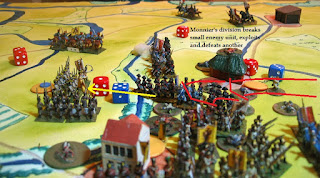The Fencibles played a first test of my Marengo scenario
last night. This is the battle that gave rise to the dish Chicken Marengo but
almost saw Bonaparte’s goose cooked 15 years early.
Rick determined to play the
Austrian Melas (in italics from here on and
in the photos) and I took the part of First Consul Bonaparte. Ken, Bill and
Jay were unable to attend so it was just the two of us. We got off to a late
start, between shooting the bull about Melas
and luck, or his lack of it. My wife Linda provided a small plastic chicken
to grace the town of Marengo. She also cooked an excellent dinner featuring
Chicken Marengo. In time we deployed and the Austrians attacked. When possible, I showed the assault dice of
both sides. Units were often formed deep (2 ranks of stands) to get the +1 in
assault. Yellow discs show disruption, casualty figures show a stand removed. Uniforms are 1809 period for the Austrians, and anything from bicornes to Bardin for the French. I figure close enough is good enough. We agreed to give a +1 in assault if infantry and cavalry were combined and then promptly forgot about it. It would only have affected one assault as far as I recall.
And that was 2 turns of action, not unlike a barroom brawl.
Both sides rolled fairly low firefight dice.
On the 4th turn the French began to fall back,
though it wasn’t done flawlessly.
We broke for dinner, that excellent Chicken Marengo done in
the style it was served on the battlefield that night, with egg and shrimp (in
place of crawfish, so dear here in NYC). After dinner and conversation, we
returned to the fray.
The arrival of Desaix’s troops caused the Austrians to halt in place and inspired
the French to start their counterattack. I figured it was unlikely I could
recapture Marengo but determined to cause crippling losses to the enemy.
Sometimes my aging camera fools me. I think it’s taking a
photo but it just focuses. As a result I have no pictures of the final French
turn, which saw a major collapse of the Austrians.
Rick’s assault dice went cold as ice and the French romped over almost
every attack made, exploiting on. Melas
went down in the final scrum; post-game dice showed he had been badly
bruised but was up on his feet again after a couple days in bed.
Victory conditions had 1 point each for control of Marengo,
the cross roads near the east edge of the board, exiting unspent units off each
side’s supply road, causing Bonaparte to be a casualty and causing twice as
many losses as taken (including removed, run away, and leaders). The final
score was Austria
French losses were 4 infantry stands removed, 3 cavalry
(including all of Kellermann) and 1 run off for a total of 8 stands, perhaps
4,000 troops. Austrian losses were 15
infantry removed, 3 run off, 2 cavalry removed and 1 run off, and Melas down for a total of 22 stands, for
a total of some 10,500 (2,000 of them would show up at the campfire in time).
We played 9 turns in about 4 hours and 30 minutes, rather slow for us. There
were constant charges except for the two turns that the French broke contact
and retreated. It didn’t follow the actual battle all that closely except in
the final regard: Austrian fortune
deserted them at the end and they collapsed.
There are a couple very small (2 stand) Austrian light
infantry units that I think would better be merged into larger units. Tiny
infantry units (and tiny disrupted cavalry units) in the front line are pretty
much disasters waiting to happen if the enemy have decent and sizeable units
within striking distance. The demise of Kellermann’s brigade was a lesson. I’ll
give the merging of the light infantry some thought. We may try this again in a
couple weeks, depending on how many Fencibles can make it. If we instead need a
small game, we could re-play the 1870 battle of Coulmiers with adjusted victory
conditions. We’ll see.
Update: We will play Marengo again this coming Thursday, with the small change to the Austrian OB mentioned above. I will take the role of the septuagenarian Melas.

























































